Gallery
- Sant Joan de Caselles Church
- Santa Coloma Church
- Sant Esteve Church
- Santa Eulalia Church
- View of Andorra la Vella
- Nave view of the Santuario de Meritxell. Note the combination of newer fixtures and elements of the original Church.
The architecture of Andorra demonstrates the varying styles of architecture in its over 800 years of existence.
Its architecture is shaped by that of its neighbours and is home to several, most notably Romanesque and Baroque while in more recent years, contemporary styles have been utilised especially between the rugged mountains of the Pyrenees. [1]
Due to Andorra's nature being situated between France and Spain, a lot of its architecture was influenced by those countries. In particular, Romanesque style of architecture which is the most dominant style that is found in Andorra. The Romanesque period (at its height between the 11th and 12th Centuries), lasted for much longer in Andorra than in other European countries due to its isolation in the Pyrenees. [2] Andorra is home to numerous churches, many dating from the 12th Century, as well as other historical buildings such as government buildings dating from the 16th Century and many houses dating from the 15th Century. The Andorra la Vella Historical District located in Andorra la Vella, the country's capital, is home to numerous buildings that range from being built in the 15th Century to the early 20th Century. [3] Some notable buildings in the Old Town include:
Casa de la Vall - formerly housed the Andorran Parliament, the Consell General. Built in the late 16th Century, the house is now open to the public with guided tours. [4]
Casa Guillemó, Molines and Cintet families - manors of various prominent Andorran families located on Plaça Príncep Benlloch.
Andorra is famous for its historical churches found across the country. These churches are especially notable as they are perfectly preserved from the Romanesque period. [5] Some notable churches include:
Sant Joan de Caselles Church - located in Canillo, it is a Romanesque church dating between the 11th to 12th Centuries. [6]
Santa Coloma Church - located just outside Andorra la Vella in Santa Coloma and is the oldest church in Andorra. [7]
Nostra Senyora de Meritxell Church - also located in Canillo, parts of the original church was destroyed by a fire in 1972 and subsequently, more contemporary elements were added to it. [8]
Sant Esteve Church - this church is located in the Old Town of Andorra la Vella that was built in the 12th Century. Numerous changes and additions were made in the 20th Century.
Santa Eulalia Church - located in the village of Encamp, the church is built in the Romanesque style during the 11th Century. [9]
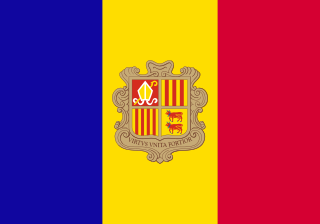
Andorra, officially the Principality of Andorra, is a sovereign landlocked country on the Iberian Peninsula, in the eastern Pyrenees, bordered by France to the north and Spain to the south. Believed to have been created by Charlemagne, Andorra was ruled by the count of Urgell until 988, when it was transferred to the Roman Catholic Diocese of Urgell. The present principality was formed by a charter in 1278. It is currently headed by two co-princes: the bishop of Urgell in Catalonia, Spain and the president of France. Its capital and largest city is Andorra la Vella.

Andorra la Vella is the capital and largest city of Andorra. It is located high in the east Pyrenees, between France and Spain. It is also the name of the parish that surrounds the capital.

La Seu d'Urgell is a town located in Alt Urgell county in Alt Pirineu, Catalonia, Spain. The town is also the head of its judicial district and the seat of the Bishop of Urgell, one of the co-princes of Andorra. It is located the most populated town of the region, with 17.4% of its population. La Seu d'Urgell and Puigcerdà together have 30% of the population of the area.

The Province of Lleida is one of the four provinces of Catalonia. It lies in northeastern Spain, in the western part of the autonomous community of Catalonia, and is bordered by the provinces of Girona, Barcelona, Tarragona, Zaragoza and Huesca and the country of France and the principality of Andorra. It is often popularly referred to as Ponent.
Andorra is essentially Catalan speaking. The country has contributed significantly to the Catalan heritage.

Taüll is a town in the province of Lleida, in Catalonia, Spain. It is home to the church of Sant Climent de Taüll, an excellent example of Romanesque architecture, one of the Catalan Romanesque Churches of the Vall de Boí declared World Heritage Site by UNESCO.

Canillo is one of the parishes of Andorra. Canillo is also the name of the main town of the parish. The parish is considered the religious center of Andorra with the Sanctuary and Chapel of Our Lady of Meritxell, patron saint of Andorra, and contains one of the best-preserved romanesque churches in the Pyrenees, Sant Joan de Caselles. It has a population of 4,826, as of 2011. Despite having a tourist vocation, the parish of Canillo still retains many livestock and agricultural traits. It borders France.

Ordino is the most northerly parish in the Principality of Andorra. It's mostly the main area of Valira del Nord or Valira d'Ordino river valley. Ordino is also the name of the main town of the parish. Other settlements in the parish are El Serrat, Ansalonga, Sornàs, La Cortinada, Llorts, Segudet, Arans, Les Salines and Arcalís. It is home to the Sorteny National Park, the largest nature area of Andorra. It has a population of 4,858, as of 2017. The town preserves a vast medieval center, mainly linked to the culture of the country.

One of the first streams of Romanesque architecture in Europe from the 10th century and the beginning of 11th century is called First Romanesque or Lombard Romanesque. It took place in the region of Lombardy and spread into Catalonia and into the south of France. Its principal decoration for the exterior, bands of ornamental blind arches are called Lombard bands. It was characterized by thick walls and lack of sculpture in facades, and with interiors profusely painted with frescoes.

La Vall de Boí is a municipality and narrow, steep-sided valley in Catalonia. It lies in the Alta Ribagorça county in the Alt Pirineu region, on the edges of the Pyrenees. In 2022, it had a population of 1,090.
Listed below are articles about or related to Andorra, arranged alphabetically:
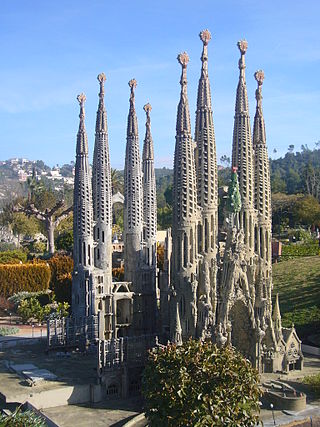
Catalunya en Miniatura is miniature park inaugurated in 1983 in Torrelles de Llobregat, 17 km (11 mi) from Barcelona. The park is 60,000 m2 (650,000 sq ft), 35,000 m2 (380,000 sq ft) of them devoted to the scale models, it is one of the largest miniature parks in the world, and the largest of the 14 miniature building exhibitions present in Europe. It displays 147 models of palaces, churches, bridges and other buildings from Catalonia and Mallorca and it includes all the major works by the renowned architect Antoni Gaudí.
The Churches of the Vall de Boí are a set of nine Early Romanesque churches declared World Heritage Site by UNESCO and located in the Vall de Boí, in the Catalan comarca of Alta Ribagorça.
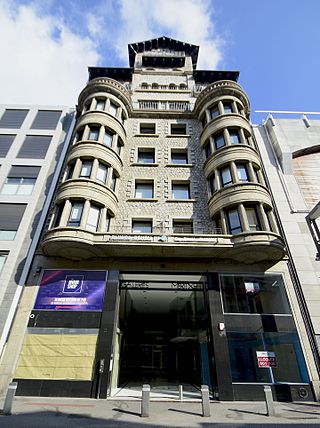
Casa Felipó is a historical building in Andorra la Vella, Andorra. Built in 1948, it is located along the Avinguda de Meritxell, just to east of the Andorra National Library and the Església de Sant Esteve. It is a heritage property registered in the Cultural Heritage of Andorra.
The Cultural Heritage of Andorra is an organization in Andorra which protects national buildings and monuments considered of cultural and historical value.
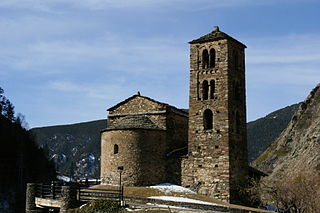
Església de Sant Joan de Caselles is a church located in Canillo, Andorra. It is a heritage property registered in the Cultural Heritage of Andorra. It was built in the 11–12th century.

The Church of Santa Coloma d'Andorra is a church in Santa Coloma, Andorra la Vella Parish, Andorra, and is Andorra's oldest church. It is a heritage property registered in the Cultural Heritage of Andorra. It is dedicated to Columba of Sens, patron saint of Andorra. The nave of the church was built in the 8th or 9th century, and the tower in the 12th century. In the church are visible remnants of murals made in the 12th century by the Master of Sant Coloma. Most of the murals were removed in 1933 and were in Berlin until 2007. These murals are now present in the Andorran Government Exhibition Hall.

Sant Joan de Boí is a Romanesque church situated in the territory of Vall de Boí, a commune in the valley of the same name, in the Province of Lleida in the autonomous community of Catalonia in Spain.
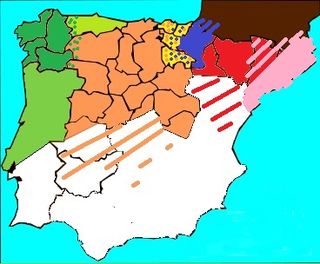
Spanish Romanesque designates the Romanesque art developed in the Hispanic-Christian kingdoms of the Iberian Peninsula in the 11th and 12th centuries. Its stylistic features are essentially common to the European Romanesque although it developed particular characteristics in the different regions of the peninsula. There is no Romanesque art in the southern half of the peninsula because it remained under Muslim rule (Al-Andalus). The examples of Romanesque buildings in the central area of the peninsula are sparse and of the latest period, with virtually no presence south of the Ebro and the Tagus. Most Romanesque buildings can be found in the northern third of the peninsula. Romanesque art was introduced into the peninsula from east to west, so scholars have usually defined regional characteristics accordingly: the "eastern kingdoms" comprising the Pyrenean areas, Catalan Romanesque, Aragonese Romanesque and Navarrese Romanesque, and the "western kingdoms" comprising Castilian-Leonese Romanesque, Asturian Romanesque, Galician Romanesque and Portuguese Romanesque.

Santa Eulàlia d'Erill la Vall is a Romanesque church situated in Erill la Vall, in the territory of Vall de Boí, a commune in the valley with the same name and in Comarca of Alta Ribagorça in the north of Province of Lleida and the autonomous communities of Catalonia in Spain.